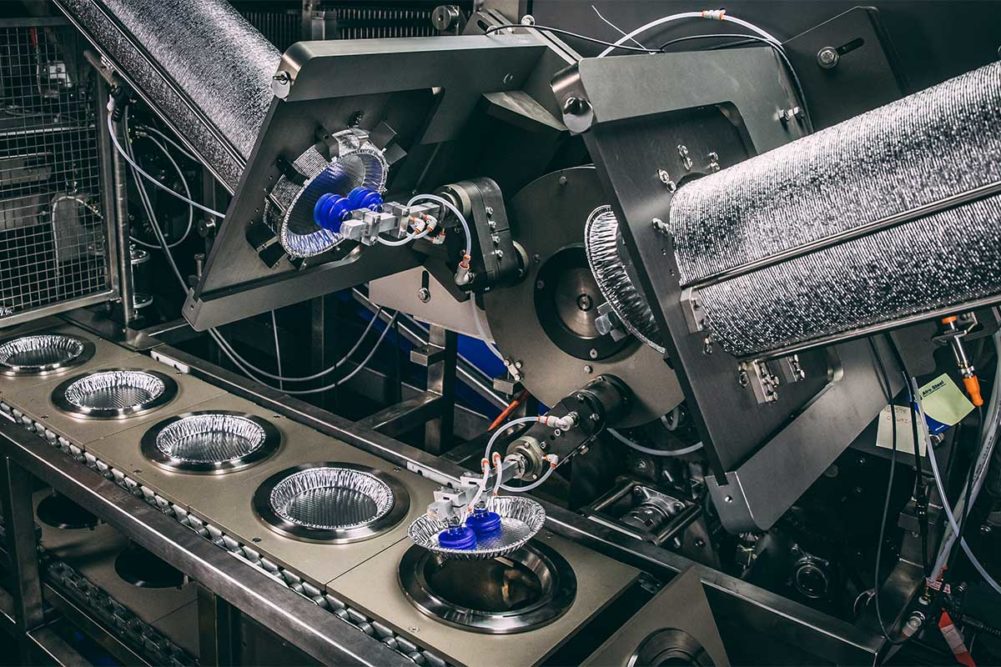Pie favorites like pumpkin and apple will always have a place in the hearts and shopping carts of consumers, but pie makers must leave space in their production schedules for new trends and formats, healthy alternatives, and limited-edition flavors.
“Consumer interest in new flavor combinations and better-for-you formulations are driving a lot of new recipes,” said Chuck Sena, director of marketing and sales, Axis Automation. “As a result, the production equipment needs to be able to handle a wider range of operating challenges. Whether it is the release properties of the dough, the viscosity of the fillings or adding nontraditional ingredients at its core, the equipment needs to be as versatile as possible. And when individual machines still do not have enough versatility, then the production needs to be set up so that different equipment can be moved into place quickly and efficiently.”
Producing hundreds of pies an hour requires equipment running at peak efficiency and accuracy. That means having certain standards in place at bakeries.
“With an automated production line, the most important aspects of efficient operation are a properly set up line in good running condition, consistency of incoming ingredients and well-trained operators,” said Nick Magistrelli, vice president of sales, Rademaker USA. “All of these aspects can be directly tied to and influenced by the quality of operators and maintenance teams. Investing in and retaining quality people is critical to this. Ongoing training is important to ensure your people are at their best.”
A high-capacity pie operation comes with a variety of challenges to keep lines running consistently.
“Pie production is very challenging when you consider the importance of a flaky, tender crust typical of a traditional American-style pie combined with the goal of high-efficiency output,” said Rick Hoskins, chief executive officer, Colborne Foodbotics.
Although the basic concept of sheeting has not changed in 70 years, servo technology has helped make machinery much more efficient, he said.
“This technology allows users to have faster changeovers, reduced maintenance and higher overall efficiencies,” Mr. Hoskins said. “This new servo technology can be implemented on our existing machines within a few days depending on the existing line.”
Servo technology provides more versatility, which can accelerate the making of pie crusts.
“The servo gives you the capability to speed up and slow down for better positioning and synchronization, which allows the chance to increase capacity,” said Ken Hagedorn, vice president of the bakery sector for Handtmann. “It’s pressing the pie dough into the foil on a scrapless line, and before you had servo drives, you were limited because the conveyor speed was always the same. Now you have the capability when you go from point A to point B you can ramp up and slow down.”
One of the first considerations for pie makers is being careful not to overwork the pie crust doughs, said Jeff Zeak, national development manager, bakery, Reiser.
“Overworking pie dough during dividing and processing can lead to a reduced volume of baked crust, less flaky and tough pie crust bottom or top,” he said. “Overworking the dough can also lead to temperature rise of the dough and increased stickiness.”
He added that stickier doughs require the use of more dusting flour.
“Increased use of dusting flour increases the cost of production and can increase the toughness of the resulting crust and stiffen the consistency of pie dough rework,” Mr. Zeak added. “The Reiser Vemag dough divider is customized to minimize dough temperature rise and resulting stickiness of dough to reduce the use of dusting flour.”
He also emphasized the importance of minimizing the addition of pie dough trim into unused or virgin dough.
“Pie dough trim rework can cause inconsistency in the performance of the pie crust — resulting in the increased shrink back of raw pressed or sheeted pie dough, reduced volume of baked crust, less flakiness and tough pie crust on bottom or top.”
Understanding the optimal amount of scrap that can be reworked into doughs is important to maintain quality and consistency, Mr. Hagedorn said.
“Sometimes they don’t put scrap in, or they put too much scrap in,” he said. “They don’t meter it in as you should. Sometimes in the same facility you have virgin dough, but maybe in the next dough they run they’re putting in so much scrap that it’s almost a completely different dough.”
The reworked dough is often put on the bottom crust for a couple of reasons.
“With an apple pie, for instance, you really don’t notice the flakiness so much on the bottom dough because you’ve got tons of filling sitting on it, so it’s never going to be as flaky,” Mr. Hagedorn explained. “But you will notice on the top dough, so you want to use the virgin dough on your lid and hide the scrap on the bottom that’s blended in with your other dough.”
Handtmann’s dough feeding system is used by pie makers because it is consistent and handles dough gently, Mr. Hagedorn added.
This article is an excerpt from the December 2022 issue of Baking & Snack. To read the entire feature on Pie Processing, click here.





